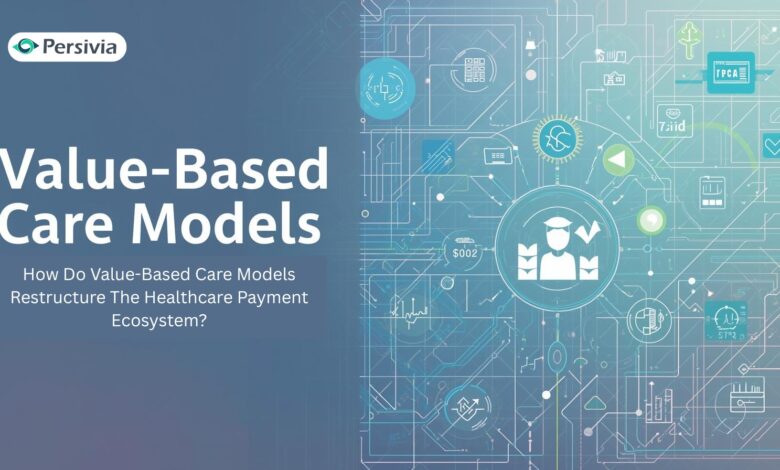How Do Value-Based Care Models Restructure The Healthcare Payment Ecosystem?

Value-based care models change the approach to healthcare, making it more about value instead of quantity, where the outcomes of the patient are rewarded instead of the number of services provided. To become a success, ACOs need to discover their core competencies, apply specific risk-reducing measures, and use data integration. The payment ecosystem has been focused on financial accountability, quality metrics, and proactive care coordination.
There is a fundamental change in healthcare payment systems. The old system of fee-for-service payment, in which hospitals made money at each test, procedure, or visit, is being replaced by a results-based model that rewards quality and efficiency. The value-based care models compensate healthcare organizations according to patient outcomes, quality of care, and cost-effectiveness instead of the number of services given.
This change isn’t happening in isolation. The CMS and commercial payers have increased the adoption of more advanced set-ups, accelerating the shift toward mature, accountable payment structures. Those organizations that hold onto their generic strategies are falling behind, and progressive-looking ACOs pose a more complex question: how can we be better in these models by using what makes us special? The solution is the realization that these models redesign all the components of the healthcare payment ecosystem, including risk allocation, data analytics, and care coordination.
Understanding Value-Based Care Models
Value-based care models are payment systems that base provider payment on health outcomes and quality measures of patients instead of volume. The plans remove the risks of payment by the payers to the providers and provide an incentive to provide efficient and high-quality care. In such models, providers gain incentives for how they maintain healthy patients and control chronic conditions.
The healthcare payment ecosystem under value-based care operates on three core principles:
- Outcome accountability: Providers assume responsibility for patient health results
- Financial risk sharing: Organizations bear some or all of the cost risk
- Quality measurement: Performance tracking through standardized metrics
The Shift in Provider Payment Structures
Value-based care is a fundamental reorganization of the money flow in the health care system. In the conventional model, a higher number of procedures done by a cardiologist increased his revenue. Under value-based arrangements, the same cardiologist receives a reward in the form of preventing heart attacks through proactive management, a reduced number of procedures, improved outcomes, and increased payment.
Payment Structure Changes
- Shared savings: Providers keep a portion of cost reductions when quality targets are met
- Capitation: Fixed per-patient payments covering all needed services
- Bundled payments: Single payments for complete episodes of care
- Quality bonuses: Additional compensation for exceeding performance benchmarks
- Downside risk: Financial penalties when costs exceed targets or quality falls short
These payment reforms demand that healthcare organizations think in terms of being a hybrid organization, which ensures clinical excellence but acquires the ability that has historically been identified with insurance companies, such as population analytics, patient stratification, and strategic allocation of resources.
Risk Assessment for ACOs
Risk assessment forms the foundation of successful value-based participation. All ACOs possess inherent strengths related to provider mix, historical orientation, and infrastructure capital. Diversity of ACO structures implies that individual organizations have different risk management benefits and issues.
Begin with the objective analysis of organizational strengths and weaknesses. An ACO whose primary specialty is cardiology is well aware of cardiac care pathways. An ACO that has strong primary care is good at dealing with multi-morbidity patients who are complex. These core competencies define the risks to take and the risks to be guarded against.
Key Assessment Areas
- What conditions do our providers manage most effectively?
- Where do we consistently deliver superior outcomes at lower costs?
- Which patient populations do we understand best?
- What infrastructure investments have we already made?
- Where do gaps in our network create vulnerability?
ACO Structure Comparison
| ACO Type | Core Strengths | Best For |
| Hospital-Affiliated | Complex acute care management, integrated systems | Reducing readmissions and complication rates |
| Independent Physician-Led | Chronic disease management, preventive care | Reducing low-value utilization through primary care |
Risk Mitigation Strategies That Work
For areas outside their core strengths, ACOs use targeted protection strategies such as stop-loss insurance or specialty partnerships instead of simply avoiding risk. The value-based care model for ACOs succeeds when organizations strategically balance risk acceptance in strength areas with mitigation in others.
Strategic Partnerships
By creating partnerships, organizations are able to deal with certain areas of risk without developing all the capabilities internally.
- Specialty risk partners: Agreement with specialty-oriented groups, which take risk on certain conditions. An oncology practice can accept capitated payments on cancer care with the help of its specialization, whereas the ACO is focused on primary care coordination.
- Post-acute partnerships: Establish preferred relationships with skilled nursing homes, home health, and rehab centers. These relationships cut post-discharge expenses and readmissions, which are usually the largest drivers of costs in value-based contracts, by a dramatic margin.
Reinsurance and Stop-Loss Coverage
Financial insurance is used as a security measure against disastrous situations. Smaller ACOs may have a stop-loss at 100,000 per patient, and large organizations at 500,000. Reinsurance cover saves ACO from crippling losses when the individual patient costs surpass these limits.
Performance protection mechanisms help organizations remain stable during unforeseen events such as disease outbreaks or demographic shifts.
The Role of Data in Value-Based Care Success
Effective risk management is based on the knowledge of your data and the knowledge of your population. In the absence of integrated data, ACOs are left to work in the dark; they do not know which patients need attention, they cannot estimate who will need the costly services that are costly and measure the real result of care improvements.
Data Integration Requirements
Value-based care models demand bringing together information from multiple sources:
- Electronic health records: Clinical data from hospital and office visits
- Claims data: Payment information showing utilization patterns
- Lab results: Diagnostic information across different testing facilities
- Pharmacy records: Medication adherence and potential interactions
- Social determinants: Housing stability, food security, transportation access
A digital health platform converts raw data to actionable intelligence. Predictive analytics singles out patients who have a high risk of being hospitalized, visiting an emergency room, or developing a disease. Predictive models help identify patients at risk of costly complications early enough to allow timely interventions.
Applying the value-based care model to the ACOs would mandate the consideration of the optimization of the provider network, the characteristics of the population, and the past performance trends in order to propose specific strategies in accordance with the weaknesses and strengths of each organization. This analysis assists in establishing the strategies that will yield the most performance be it the ACO is hospital-based or an independent one.
Identifying Core Competencies for Success
Review where your organization consistently achieves better outcomes at lower costs. The advanced ACOs assign resources strategically depending on the strength of their organization instead of equally allocating efforts to all areas.
Competency Identification Process
- Review historical performance: Implement the quality metrics and cost data analysis under various conditions and patient groups.
- Assess provider expertise: Where do your clinicians receive special training and experience?
- Evaluate infrastructure: Think of current care coordination, investments in technology, and network relationships.
- Examine patient demographics: Learn your most effective population to serve.
An ACO that specializes in cardiology may be willing to take full responsibility for providing cardiac care since its special protocols are proven to provide better results. An organization that has outstanding primary care and quality chronic disease management programs may shine with complex and multi-morbidity patients that other organizations do not manage effectively.
Infrastructure Requirements for Value-Based Care
Organizations require functioning capacity in addition to the conventional clinical care provision. The transition requires a care coordination framework that follows patients along complicated medical pathways, providing a seamless transition between primary care, specialists, hospitals, and post-acute care.
Essential Components
- Care coordination: Teams that promote communication between the providers and settings.
- Patient engagement tools: Telehealth application, remote monitoring tools, and mobile medication reminder apps.
- Performance tracking: Live dashboard displays with performance based on quality benchmarks and financial targets.
- Predictive analytics: Systems that preempt high-risk patients before they have health crises.
Patient Benefits Under Value-Based Models
Patients are treated in a more coordinated and proactive way that takes into consideration their health as a whole and not individual medical events. With value-based models, the provider has time and money to offer intensive preventative care visits, organize the treatment plans among various conditions, and post-hospital follow-ups to avoid complications.
Patients have less repetition of tests, enhanced communication among providers, and teams of care providers that are aware of their complete medical history and personal situations. The model complies with the obstacles to health, such as transportation and medication expense, that are overlooked in contemporary fee-based service plans, resulting in enhanced health care and patient satisfaction.
Common Challenges in Value-Based Transitions
The shift to value-based care is a complex operation and financial challenge. The challenge of forecasting healthcare budgets is one that is not easy to handle, because disease outbreaks, expensive specialty drugs, and disastrous patient outcomes can ruin annual budgets.
Common Obstacles
- Financial uncertainty: Organizations without appropriate risk protections may face unsustainable losses
- Provider resistance: Physicians accustomed to fee-for-service may resist changes to practice patterns
- Technology requirements: Many legacy systems lack the data exchange and analytics needed for value-based care workflows
- Measurement complexity: ACOs must track dozens of measures across different payer contracts
Being aware of these challenges would enable organizations to make the necessary preparations and apply solutions to their problems before they grow out of proportion.
Takeaway
Value-based care model is transforming the process of delivering and financing care. The effective ACOs do not merely follow the generic strategy, but instead develop plans out on their own strengths. With the help of integrated data, they can identify the risk early enough, proactively manage populations, and align care delivery to quantifiable outcomes. This would be achieved through self-analysis, good collaborations, and technology that transforms data into actionable ideas.
About Persivia
Persivia’s AI-based analytics platform helps ACOs succeed in value-based care in value-based care. It consolidates EHR, claims, and clinical data to generate longitudinal patient records to be used in making smarter risk management. Organizations can see the real-time population health, identify the high-risk patients in time, and monitor the quality performance. The platform compares provider networks and population trends to suggest proactive measures that will help care teams to be more proactive and avoid high-cost events.



